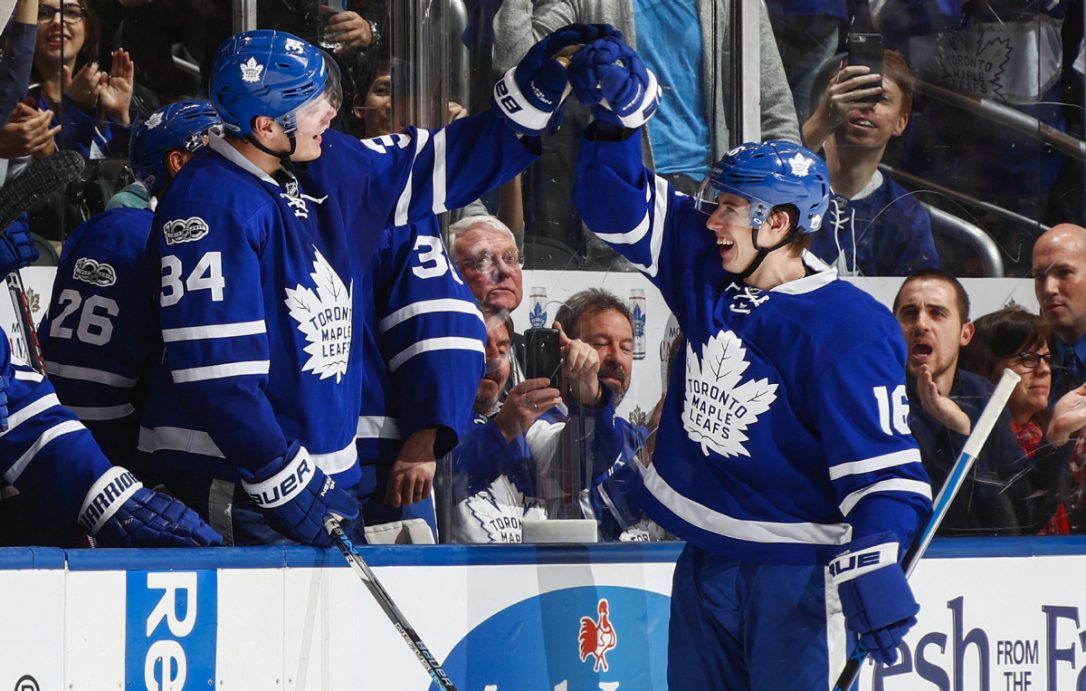When discussing the addition of Patrick Marleau earlier this month, GM Lou Lamoriello provided an interesting quote on Leafs management’s concern about the difficulty of the second season for the Leafs (now-former) rookies:
How about this then: Did that make you guys more excited, the fact that they went toe-to-toe with the President’s Trophy winners?
Lamoriello: Oh, I think it made everybody excited, but you also have to take a step back and understand how difficult it is coming off of that in going into the second year. The second year is the most difficult on young players for a lot of different reasons, especially when they have success. The reason for a move like this is to make sure that we help not have that happen because it’s, “I’m okay,” or maybe [we think] we’re better than we are. All of these things go through your mind. If you don’t address them, you’re going to get caught. It’s just the nature of the way people think and certainly the way players think. This is a tough league. Going into last year, there were teams that didn’t make the playoffs that were really pencilled in to be top two or three. We have to make sure that we think of everything and look at everything, and when you have an opportunity to sort of put your odds in a better shape, you do it.
My first reaction: When it comes to concerns about the repeatability of last year’s offensive success, I tend to look at the overall health of the team as well as the career years of James van Riemsdyk, Tyler Bozak, Jake Gardiner and Nazem Kadri. While I could see a “sophomore slump” potentially factoring in with players such as Zach Hyman, Connor Brown or Nikita Zaitsev, ‘The Big Three’ (Auston Matthews, William Nylander, Mitch Marner) are true “drivers” and special enough talents where this appears unlikely, barring significant injuries. And if that’s true, by how much could we realistically expect them to improve on their rookie-year numbers as sophomores?
To test this hypothesis, I compiled the list of 20-and-under rookie forwards who played 45 or more games and achieved a points-per-game rate of .70 or higher in their rookie season dating back to 1990. I then looked at how their production evolved in their sophomore years.
Sophomore Production of Rookies with .70 Pts/GP or higher, min. 45 GP (1990-2017)
| Rookie | Age | Pts/GP | Sophomore | Pts/GP | Difference |
|---|---|---|---|---|---|
| Alex Ovechkin | 20 | 1.31 | Alex Ovechkin | 1.12 | -0.19 |
| Sidney Crosby | 18 | 1.26 | Sidney Crosby | 1.52 | +0.26 |
| Eric Lindros | 19 | 1.23 | Eric Lindros | 1.49 | +0.26 |
| Evgeni Malkin | 20 | 1.09 | Evgeni Malkin | 1.29 | +0.20 |
| Connor McDavid | 19 | 1.07 | Connor McDavid | 1.22 | +0.15 |
| Alexei Yashin | 20 | 0.95 | Alexei Yashin | 0.94 | -0.02 |
| Pavel Bure | 20 | 0.92 | Pavel Bure | 1.33 | +0.40 |
| Patrick Kane | 19 | 0.88 | Patrick Kane | 0.88 | 0.00 |
| Patrik Laine | 18 | 0.88 | |||
| Jason Arnott | 19 | 0.87 | Jason Arnott | 0.88 | +0.01 |
| Scott Gomez | 20 | 0.85 | Scott Gomez | 0.83 | -0.02 |
| Anze Kopitar | 19 | 0.85 | Anze Kopitar | 0.94 | +0.09 |
| Nicklas Backstrom | 20 | 0.84 | Nicklas Backstrom | 1.07 | +0.23 |
| Auston Matthews | 19 | 0.84 | |||
| Ryan Nugent-Hopkins | 18 | 0.84 | Ryan Nugent-Hopkins | 0.60 | -0.24 |
| Jonathan Toews | 19 | 0.84 | Jonathan Toews | 0.84 | 0.00 |
| Paul Kariya | 20 | 0.83 | Paul Kariya | 1.32 | +0.49 |
| Mitch Marner | 19 | 0.79 | |||
| Ilya Kovalchuk | 18 | 0.78 | Ilya Kovalchuk | 0.83 | +0.04 |
| Filip Forsberg | 20 | 0.77 | Filip Forsberg | 0.78 | +0.01 |
| Nathan MacKinnon | 18 | 0.77 | Nathan MacKinnon | 0.59 | -0.17 |
| Jeff Skinner | 18 | 0.77 | Jeff Skinner | 0.69 | -0.08 |
| Brad Richards | 20 | 0.76 | Brad Richards | 0.76 | 0.00 |
| Pat Falloon | 19 | 0.75 | Pat Falloon | 0.68 | -0.06 |
| William Nylander | 20 | 0.75 | |||
| Mats Sundin | 19 | 0.74 | Mats Sundin | 0.95 | +0.21 |
| Jaromir Jagr | 18 | 0.71 | Jaromir Jagr | 0.99 | +0.27 |
| Rookie | Sophomore | Difference | 82-Game Difference | |
|---|---|---|---|---|
| Goals Per Game | 0.37 | 0.41 | 0.05 | +3.98 Goals |
| Assists Per Game | 0.52 | 0.59 | 0.07 | +5.81 Assists |
| Points Per Game | 0.88 | 1.00 | 0.12 | +9.79 Points |
First of all, there are 27 players on this 27-year list, meaning we get an average of one rookie higher than .70 points per game (minimum 45 GP) per year – further underscoring just how special it was to have three in the same year on the same team.
If we look at it from the perspective of many players improved, how many stayed about the same, and how many dropped: 18 of the 23 produced about the same or better in their sophomore seasons (10 improved by more than .05 Pts/GP, eight stayed within 0.05 Pts/GP, five decreased by more than .05 Pts/GP).
After a 40-goal rookie season (the first since Alex Ovechkin in 2005-06) immediately following his draft year, I’m certainly comfortable putting Matthews in the generational conversation alongside the players at the top of this list, but not as much with the other two. I also wonder if Matthews would’ve been in that exclusive point-per-game plus club if someone like Marleau was on his left last season instead of Zach Hyman playing his off wing. Further, Matthews is the only one on this list to play his rookie season almost exclusively with two rookies at 5v5.
Let’s drop the five exceptional point-per-game (or better) rookies from the list:
| Rookie | Sophomore | Difference | 82-Game Difference | |
|---|---|---|---|---|
| Goals Per Game | 0.33 | 0.38 | 0.05 | +3.97 Goals |
| Assists Per Game | 0.48 | 0.52 | 0.04 | +3.19 Assists |
| Points Per Game | 0.82 | 0.90 | 0.09 | +7.16 Points |
With McDavid, Crosby, Lindros, Malkin and Ovechkin removed, the goals per game increase in year two remains just about the same but the assist rate falls and therefore the point per game increase is reduced to 7.16. If Marner and Nylander improved by the average amount among this cohort, they would finish 2017-18 with 68 points apiece over 82 games. Injecting some of my own opinion/projection here, I’d say the three have a good shot at breaking into the 65-70 point range, health permitting, with Matthews moving into point-per-game or above territory.
It’s worth noting some of the players in the immediate PPG vicinity of Nylander and Marner did either stagnate or drop in their sophomore seasons – Filip Forsberg, Jeff Skinner, Nate MacKinnon, Brad Richards, and Pat Falloon. However, the two examples of what I would view as notable “sophomore slumps” on this list are the second years for Nugent-Hopkins and MacKinnon. Both dealt with injuries (the same goes for Jeff Skinner if you wanted to include him here), with MacKinnon playing 64 games and Nugent-Hopkins appearing in just 40. MacKinnon also went from a good Avalanche team that made the playoffs in his rookie year to a mediocre one that missed in his sophomore season. One of many factors at play there was the trading of Paul Stastny, who MacKinnon produced well alongside (3.59 on-ice GF60). In any event, the original hypothesis is valid – it’s very rare for rookies of this calibre to take a significant step backwards in their sophomore season without injuries being involved.
In Summary
A lot went right for the Leafs en route to finishing fifth in the league in total offense last season – their entire top-nine forward group appeared in 78 or more games, and JVR, Kadri, Bozak and Gardiner all had career years, with Kadri scoring 32 goals. The rookies were better than expected and now have to perform with the pressure and expectation that they’ll be able to improve on their impressive accomplishments of 2016-17 (which is the challenge Lamoriello is likely referring to above). However, as Lamoriello mentioned in the quote at the top of the article, Leafs management did not rest on their laurels this offseason. They added Patrick Marleau to their top-nine forward group and power play without (as of this writing) subtracting anything. The Leafs will also have Dominic Moore – who scored 11 goals and 28 points last season – at the fourth-line spot from game #1 onward this year, replacing the mishmash of not overly productive players who occupied that role in the lineup last year (Holland, Smith, Gauthier, even Boyle – while he transformed the line’s possession numbers – did not produce any offense of note in the regular season. Granted, some of this may have to do with carting Matt Martin around). Combined with the collective improvement of The Big Three as they enter their second seasons, the Leafs appear well positioned to repeat the feat as one of the top offenses in the league next year.



































